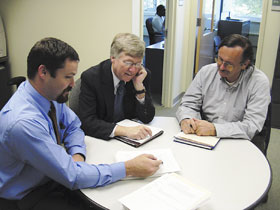Instructional Designers Help Faculty
Enhance Their Courses
 |
| Desmond McCaffrey, left, an instructional designer, works with pharmacy professors Jim Henkel, center, and Gerry Gianutsos, to refashion a course they have been teaching for more than 20 years. |
|
Photo by Dan Mercier |
Jim Henkel has taught Pharmacy 220 for 20 years. But far from the stereotypical image of the longtime professor shuffling through a sheaf of yellowing lecture notes, when Henkel wants to review his lectures he pulls a two-inch plastic capsule from his pocket. The device, attached to his keychain, contains a full audio recording of this semester’s lectures and can be plugged into any computer anywhere for playback.
The technology used to record the lectures is just one of many innovations Henkel and his colleague Gerry Gianutsos, both pharmacy professors, introduced into the course this spring, with the help of Desmond McCaffrey, a member of UConn’s Instructional Design Team.
The Team, a part of the Institute for Teaching and Learning, was launched three years ago. It now consists of four instructional designers, who have a background in education, and two media developers, trained in computer science.
The team is available to any faculty member looking for advice on teaching, and has helped redesign courses in subjects as diverse as art history, economics, marketing, poetry, statistics, and sociology, including general education courses.
“Faculty members are welcome to come to us with any teaching problem,” says Dan Mercier, director of the Instructional Design Team, “and if we’re not able to help directly, we’ll help identify resources either within or outside the University.”
Mercier says the team works with both junior and senior faculty. Some may want assistance with a course they haven’t taught before; others may want to revamp a course they have been teaching for a long time.
Team Work
Instructional designers work closely with faculty. “It’s a
team approach,” says
Mercier. “They’re the content experts. We’ll help them present
the materials in the best manner.”
The course Henkel and Gianutsos took to the team is an intensive first-year pharmacy course on drugs and their use in treating the nervous system. The class meets for two hours a day, three times a week, and the ground covered is extensive.
“Some students likened it to trying to drink from a fire hydrant,” says Henkel.
Another problem was that although the two professors might teach the class on the same day, their websites were unconnected, so that students preparing for a single class had to visit two different sites.
Henkel and Gianutsos wanted to improve the course, but weren’t sure how to do it. So they approached the Instructional Design Team for help.
“We set out to try and create something more coherent for the students,” says Gianutsos.
After observing the professors’ teaching styles, reviewing the demographics of the class, and surveying the students’ preferred methods of learning, McCaffrey, one of the instructional designers, sat down with the instructors to set goals for the course.
“All courses need clear objectives, and clear ways to measure whether those objectives have been achieved,” says Mercier.
Together, over a period of six months, the two professors and the instructional designer devised a variety of activities suited to different learning styles, including group tasks and individual units, and self-tests as well as regular tests.
“Some students learn better when they can hear something. Others like to see, say, a demonstration of molecular structure changing. Others might benefit from building a model of a molecule,” says McCaffrey. “We all learn via a number of senses, and we want to give students as many options as possible.”
Using WebCT Vista, an enhanced version of the course software that Henkel and Gianutsos had been using, McCaffrey helped combine and streamline their websites.
They also decided to use the website not only for reinforcing what is taught in class but sometimes also for introducing material not presented in class, to reduce the emphasis on lectures.
“Having a neutral third party really helped us get the material straightened out so that we organized it in the most efficient, logical way,” says Henkel.
McCaffrey also identified a new freeware program that, together with a wireless microphone, effectively turns a desktop or laptop computer into a digital recording machine, allowing Henkel and Gianutsos to record each class and make it available online to students for reference or review.
“We hope the redesigned course will achieve enhanced and more efficient learning,” says Henkel, “and we expect it will be a much better experience for the students.”
Although the introduction of new educational technologies was an important part of upgrading Henkel and Gianutsos’ pharmacy course, the Instructional Design Team emphasizes that technology is but a means to an end.
“Before any type of material is used, you have to ensure it’s valid and relevant to the class,” says McCaffrey. “Just because there’s a computer in the classroom, it doesn’t mean you have to use it.”
Looking to the Long-Term
Once the redesigned pharmacy course was launched, the team continued to monitor
it. “We take a very personal interest in the courses we design,” says
McCaffrey.
“We haven’t yet cut ourselves from a course we’ve designed,” adds Mercier.
But although the instructional designers stay in touch, they also emphasize training faculty in skills they can apply independently in the future.
“If we didn’t take a faculty development approach, they’d be back next year saying ‘you did it for us, but we don’t know how,” says McCaffrey. “I’ve shown Gerry [Gianutsos] how to upload files to the web, for example, and now he does it himself.”
Gianutsos plans to rework another course next spring – on pharmacy law. Says Gianutsos, “I’ll try to pattern it after what I learned.”

